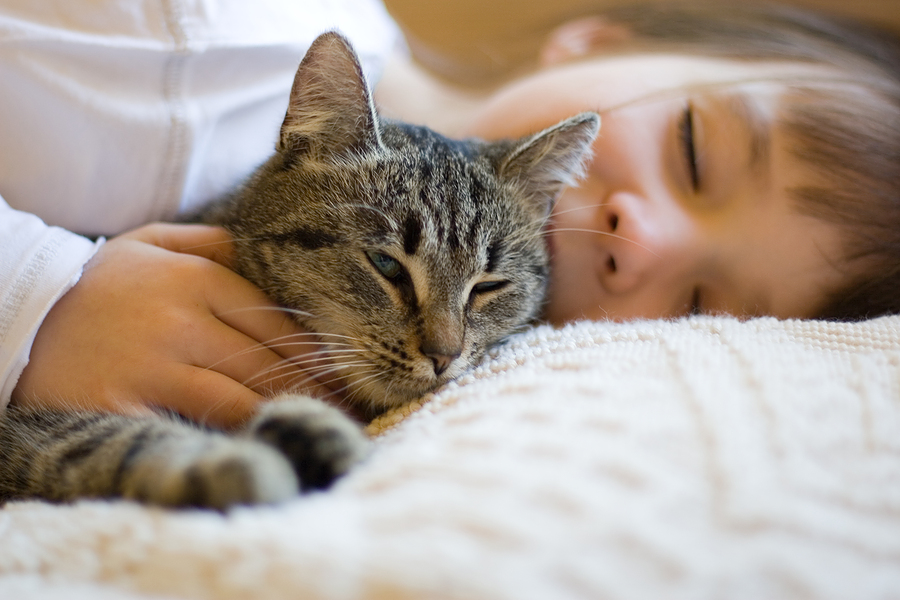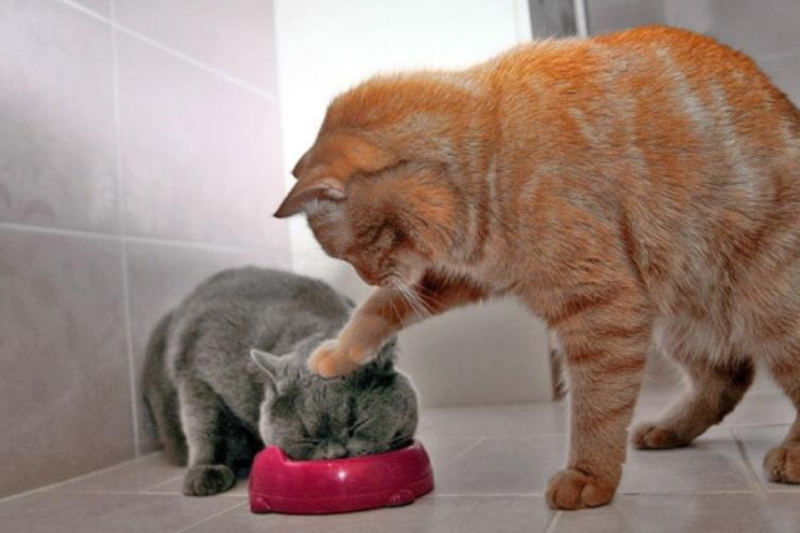
WHY DO CAT PURR?  Cats purr in a variety of situations and there are a number of theories as to why they do it. It could even be therapeutic.
WHY DO CATS PURR? The fascinating thing about purring is that cats will do it when they are feeding their kittens, to communicate with other cats, when being patted and when relaxed, but they will also purr when in distress. Cats who have suffered trauma such as being hit by a car, or are at the vet clinic will often purr, despite being obviously in pain or discomfort. Purring is found in Felids and also Genets, but no other species. Kittens will purr at only a few days old. WHAT DOES PURRING MEAN? In some cases cats purr because they want to be fed and many cats have essentially trained their owners that this noise means they should hop to it and get that food bowl filled. They also purr to communicate with their kittens and kittens can purr while suckling. They may also purr to diffuse confrontations with other cats and to indicate they don’t want to fight. The purr is also theorised to be a form of self-soothing, which might explain why they purr at the vet or while in pain. HOW A PURR IS MADE When a cat purrs the inspiratory and expiratory phase of breathing is equal. There is no specific purr structure, but it is thought to originate in the larynx and vocal folds. Some lucky scientists have dedicated their careers to analysing the purr of Felids and have found the frequency varies slightly during the inspiratory and expiratory phase. It is frequently quoted as being between 25-150 Hertz. THERAPEUTIC PURRING A wonderful theory about purring is that it could contribute to fracture repair and healing in the cat. The frequency of a purr is in the range that aids healing and maintains bone density. Cats often clock up 18 hours of sleep a day, which doesn’t leave much time for the weight bearing exercise necessary to maintain bone density. Perhaps cats need to be included in the space program, where decreased bone density is a known problem? Whatever the cause purring has certainly evolved as a form of communication between cat and pet owner. This lovely sound signals contentment when being patted, but also could be a form of self-healing and self-soothing. |
HELP! MY CAT WON'T EAT!
 If your cat is fussy, a little sick, elderly or you need to change foods, you may have encountered how much your cat dislikes change. Helping your cat to like a new food or transition onto a special diet, or perhaps even eat when he may be a little under the weather or unable to smell can be a challenge. Here we share some hints and tips to encourage your cat to eat. Please note: if your cat is not eating, the most important thing is to visit your vet to work out why your cat is not eating. This article is not a substitute for your veterinarian’s advice. WHY CHANGE DIET?
|
|
CATS AND CAR TRAVEL 
If you’re a first-time cat owner, you may have heard some horrendous horror stories about traveling with a cat. If you’re a long-time cat owner, you might have experienced some of those horrendous horror stories. It’s certainly true that cats tend to be somewhat unenthusiastic travelers. But if you’re prepared, have the proper equipment, and plan your road trip with a cat’s eye view, all will go well. START PREPARING EARLYHere’s a hypothetical for you: Let’s say that your cat is about 5 years old. Let’s say that you’re planning a road trip with your cat. When should you start preparing for the trip? About 5 years ago! That’s because the single most important thing you can do to prepare your cat for car travel is to sensitize it to the experience. For a brief time period, a kitten is very open to experiencing and becoming accustomed to new experiences. That prime time occurs from about 2 to 7 weeks of age. If you’ll take a kitten on some short car trips during that time period, the kitten will become accustomed to car travel. It may never particularly like it, but it will tolerate it. But if you take that 5-year-old cat on a trip when it’s never even been in a car before… well, let’s just say the experience might be rather traumatic – for all involved! CAR TRAVEL CHECKLISTIf you’ve ever traveled with a baby before, you know that 1 baby on the trip equals lots of extra stuff: diaper bags, bottles, blankets, binkies, and so on. Traveling with your cat will be similar. You’ll need lots of stuff to keep kitty healthy and happy (or at least contented!). Here’s a checklist of must-have items that you’ll not want to leave home without:
STOP, REVIVE, SURVIVEIf you’re the type that likes to hit the road hard and drive 5, 6, 7 hours at a stretch, you’ll need to change to accommodate kitty. Plan to stop every couple of hours to give your cat a break. If you’re in a safe location, you can let your cat out of the carrier for a few minutes – but BE CAREFUL. If the cat is stressed it might be inclined to bolt at the first opportunity. Be sure your cat is wearing its ID tag. When you do stop, be sure not to leave your car parked in direct sunlight with the windows rolled up – not even for a couple of minutes. And don’t leave your cat in direct sunlight on a warm day inside or outside of the car. TALK TO YOUR VETBefore you take that first trip with your cat, have a chat with your vet. There are medications available that can help to make the trip a more pleasant experience for both you and kitty: Medications for motion sickness, for example, or for anxiety. Your cat may not need them, but it would be good to know what’s available. You might even choose to have some medications on hand – just in case. ROAD TRIPPING WITH YOUR CAT CAN BE FUNAnd at least be tolerated by your cat. Plan ahead, bring along some of the cat’s comforts of home, take things easy with plenty of rest stops, and all is likely to go well. Let it be someone else who has those horrendous horror stories to tell! |
TAKING YOUR CAT ON HOLIDAYS WITH YOU
 Can’t imagine leaving your cat behind while you go on holiday? With just a little planning, you can bring all members of your family along on your next getaway, including your beloved cat. Do you feel that your cat is a genuine part of the family? Chances are your pet feels the same way. It is unsettling for animals to be left behind when you go away on holiday. Not so long ago, you had little choice but to place your beloved animal in a kennel while you were away. While these are still valid choices, they are costly and simply not suitable for some owners or their pets. Fortunately, more and more destinations are willing to accommodate people holidaying with their pets. So with just a little extra planning, you can enjoy taking your furry friend on your next trip away. TRANSPORTTrain, plane or automobile? Whether you are taking a driving holiday or flying to your destination, you will need the right restraints to keep your cat safe. For driving, a safety harness or a barricade across the backseat is important. Also make sure there is good ventilation. If you have a cage, be sure that it is an ample size and don’t forget about shade. For those taking to the skies, check with your airline as they will have strict rules about cat carriers and even cat breeds. For instance, Qantas provides detailed guidelines online. Excess baggage fees may also apply so do your homework in advance. You will also need an authorised crate or carrier to fly on a plane. Luckily, there is no need to invest in purchasing an expensive carrier just for a one off holiday. You can easily hire one from places such as Jet Pets which are specifically designed for air travel. TOILET STOPS AND BREAKSHead off on your Aussie road trip with a water bowl, treats and food for your cat. Keep plenty of bottled water on hand in case tap water isn’t available. Make sure you allow extra travel time for toilet and exercise breaks when planning your drive. It’s nicest, and safest, to take rest stops at a park or playground so you and your cat can have a walk around. Cats easily suffer heat stress, so never leave your pet in the car unattended. Also consider buying shade screens for the windows if the cat will be travelling in the back of your car. ACCOMMODATIONThe internet is your best friend when it comes to finding pet friendly accommodation. This can range from farm stays to pet-friendly B & B’s, camping and caravan parks. Before you book, it is important to check the in-house rules. Do they allow animals matching your pet’s size? Do you need to bring your pet’s bedding? Are cats allowed inside or outside only? Is there a fenced area for them? It is best to pick accommodation which allows a close match with your cat’s usual routine. Best of all, you are no longer stuck with the outskirts of town. If you want to enjoy a city-escape, you can now stay in an inner-city Melbourne or Sydney hotel and not compromise on lifestyle. For instance, right on Sydney Harbour The Sebel Pier One hotel has a pet-friendly policy so why not let kitty enjoy a bit of pampering while you are away? PET HEALTHAlthough we hope it never happens, anyone can get sick on holidays. So before heading off, find out where the local vet or pet hospital is. This is particularly important if you are going camping or heading somewhere remote. Also don’t forget to pack any pet medication you may need and take enough for the whole time you are away. CAT SITTINGOnce you are on your fabulous holiday, what do you do if you want to check out that fantastic new show or gourmet restaurant up the road? If you think you will want some time without the cat in tow, enquire about a cat sitter. Check with your accommodation first. Do they offer this service? If not, are there any reliable sitters in the area? Will they come to you or do you take the catto them? Just look into this before you go ahead and book your accommodation so you will not be disappointed. PETS ARE A BIG PART OF OUR LIVESIt’s great to be able to include pets in our family fun. Although a little extra planning is needed, taking the cat with you on holidays is a rewarding experience for you and your pet. By choosing the right accommodation, taking the cat’s favourite toy, familiar bedding and paying attention to details for your cat’s health and safety while on the move, your holiday can be fun and a stress free for everyone. |
 ALL RIGHT RESERVED ALL RIGHT RESERVED |